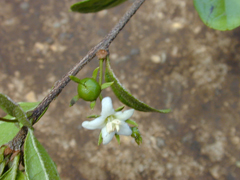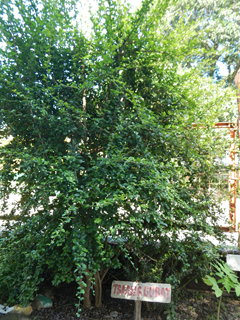 |
|
Forest Starr & Kim Starr http://www.starrenvironmental.com/ |
 |
| Ramon FVelasquez wikimedia.org |
Translate this page:
Summary
Carmona retusa or commonly known as Fukien Tea or Philippine Tea Tree is a 4 m tall deciduous well-branched shrub with small white flowers and small drupe fruits. The fruit is consumed raw while leaves infusion is used as a tea substitute. In the Philippines, the plant is considered as one of the most important medicinal plants. The leaves are used in the treatment of cough, diarrhoea, colic, and dysentery. The root is an antidote to plant-based poisoning and is used against haemorrhage and for cleaning the body after giving birth. C. retusa is also planted as an ornamental hedge. Found In: Asia, China, Hawaii, India, Pacific, Papua New Guinea, Philippines, PNG, SE Asia, Taiwan, USA. Other Names: Pala, Bapanaburi, Pitta, Pisniki, Barranki, Buri, Piccaka, Kuruvingi, Kalamoga, Kattuvettilai, Bute, Ennebutige, Kujapponno, Ponnomari, Fuku-man-gi, Icha.
Physical Characteristics

 Carmona retusa is an evergreen Shrub growing to 3 m (9ft) by 3 m (9ft) at a fast rate.
Carmona retusa is an evergreen Shrub growing to 3 m (9ft) by 3 m (9ft) at a fast rate.
See above for USDA hardiness. It is hardy to UK zone 10.
Suitable for: light (sandy), medium (loamy) and heavy (clay) soils. Suitable pH: mildly acid, neutral and basic (mildly alkaline) soils and can grow in saline soils.
It cannot grow in the shade. It prefers moist soil. The plant can tolerates strong winds but not maritime exposure.
UK Hardiness Map
US Hardiness Map
Synonyms
Carmona heterophylla Cav. Carmona microphylla (Lam.) G.Don Cordia retusa Vahl Ehretia buxifolia Roxb
Plant Habitats
Edible Uses
Edible Parts: Fruit Leaves
Edible Uses: Tea
Fruit - raw[ 301 , 317 ]. An infusion of the leaves is used as a substitute for tea[ 301 , 310 , 345 ]. The leaves are dried in the shade and used as a tea. The fruit are eaten.
References More on Edible Uses
Medicinal Uses
Plants For A Future can not take any responsibility for any adverse effects from the use of plants. Always seek advice from a professional before using a plant medicinally.
Antibacterial Antidiarrhoeal Antidote Antitussive Dysentery Febrifuge Stomachic
The leaves are antidiarrhoeal, febrifuge and stomachic[ 310 ]. An infusion is used as a remedy for stomach problems, dysentery and coughs[ 310 , 345 ]. The root is considered an antidote against plant-based poisoning and an alterative in cachexia and syphilis[ 310 , 345 ]. Furthermore, it is traditionally used to stop the haemorrhaging resulting from the bite of the viper Echis carinatus[ 310 ] The roots are reported to be ingested to clean the body after childbirth[ 310 ]. The plant has been shown to contain a range of medically active constituents. The leaves contain rosmarinic acid, flavonoid glycosides and triterpenoids[ 310 ]. Rosmarinic acid, a phenylacrylic acid derivative, is a known inhibitor of histamine release and a methanol extract of the leaves has shown strong antihistamine release properties[ 310 ]. In an experiment in the Philippines, tablets from the dried leaves reduced the formation of micronucleated polychromatic erythrocytes induced by mitomycin C, tetracycline, and dimethylnitrosamine. This suggests that these tablets possess antimutagenic activity[ 310 ] The root bark contains ehretianone, microphyllone and ehretianone[ 310 ]. Ehretianone, a quinonoid xanthene, has been shown to give protection against the action of snake venom[ 310 ]. Microphyllone and ehretianone have shown antibacterial activity against a panel of bacteria[ 310 ]. Many membes of this genus contain pyrrolizidine alkaloids and quinoid or phenolic compounds[ 310 ].
References More on Medicinal Uses
The Bookshop: Edible Plant Books
Our Latest books on Perennial Plants For Food Forests and Permaculture Gardens in paperback or digital formats.

Edible Tropical Plants
Food Forest Plants for Hotter Conditions: 250+ Plants For Tropical Food Forests & Permaculture Gardens.
More

Edible Temperate Plants
Plants for Your Food Forest: 500 Plants for Temperate Food Forests & Permaculture Gardens.
More

More Books
PFAF have eight books available in paperback and digital formats. Browse the shop for more information.
Shop Now
Other Uses
Hedge
Other uses rating: Low (2/5). Agroforestry Uses: The plant can be grown as an ornamental hedge[ 310 ].
Special Uses
Hedge
References More on Other Uses
Cultivation details
The plant has escaped from cultivation in Hawaii and become naturalized in secondary vegetation[ 305 ]. Plants can flower all year round[ 372 ].
References Carbon Farming Information and Carbon Sequestration Information
Temperature Converter
Type a value in the Celsius field to convert the value to Fahrenheit:
Fahrenheit:
The PFAF Bookshop
Plants For A Future have a number of books available in paperback and digital form. Book titles include Edible Plants, Edible Perennials, Edible Trees,Edible Shrubs, Woodland Gardening, and Temperate Food Forest Plants. Our new book is Food Forest Plants For Hotter Conditions (Tropical and Sub-Tropical).
Shop Now
Plant Propagation
Seed, Cuttings, preferably of top shoots or young leafy shoots[ 310 ]. The roots develop slowly over a period of 1-2 months[ 310 ].
Other Names
If available other names are mentioned here
Carmona retusa or commonly known as Fukien Tea or Philippine Tea Tree. Other Names: Pala, Bapanaburi, Pitta, Pisniki, Barranki, Buri, Piccaka, Kuruvingi, Kalamoga, Kattuvettilai, Bute, Ennebutige, Kujapponno, Ponnomari, Fuku-man-gi, Icha.
Native Range
TEMPERATE ASIA: China (Guangdong Sheng (south), Hainan Sheng), Japan (Ryukyu Islands), Taiwan TROPICAL ASIA: India, Sri Lanka, Indonesia (Papua), Papua New Guinea, Solomon Islands, Indochina, Myanmar, Thailand, Indonesia (Jawa, Lesser Sunda Islands, Maluku, Sulawesi, Sumatera), Malaysia, Philippines AUSTRALASIA: Australia (Queensland (north))
Weed Potential
Right plant wrong place. We are currently updating this section.
Please note that a plant may be invasive in one area but may not in your area so it's worth checking.
May be a noxious weed or invasive. An invasive weed in Hawaii where it is a popular ornamental plant.
Conservation Status
IUCN Red List of Threatened Plants Status : This taxon has not yet been assessed

Growth: S = slow M = medium F = fast. Soil: L = light (sandy) M = medium H = heavy (clay). pH: A = acid N = neutral B = basic (alkaline). Shade: F = full shade S = semi-shade N = no shade. Moisture: D = dry M = Moist We = wet Wa = water.
Now available:
Food Forest Plants for Mediterranean Conditions
350+ Perennial Plants For Mediterranean and Drier Food Forests and Permaculture Gardens.
[Paperback and eBook]
This is the third in Plants For A Future's series of plant guides for food forests tailored to
specific climate zones. Following volumes on temperate and tropical ecosystems, this book focuses
on species suited to Mediterranean conditions—regions with hot, dry summers and cool, wet winters,
often facing the added challenge of climate change.
Read More
Expert comment
Author
(Vahl) Masam.
Botanical References
Links / References
For a list of references used on this page please go here
A special thanks to Ken Fern for some of the information used on this page.
Readers comment
| Add a comment |
|
If you have important information about this plant that may help other users please add a comment or link below. Only comments or links that are felt to be directly relevant to a plant will be included. If you think a comment/link or information contained on this page is inaccurate or misleading we would welcome your feedback at [email protected]. If you have questions about a plant please use the Forum on this website as we do not have the resources to answer questions ourselves.
* Please note: the comments by website users are not necessarily those held by PFAF and may give misleading or inaccurate information.
To leave a comment please Register or login here All comments need to be approved so will not appear immediately.
|
|